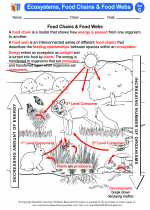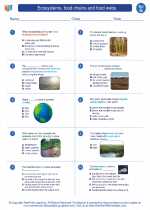Grasslands
Grasslands, also known as prairies or savannas, are ecosystems dominated by grasses and other herbaceous plants, with few or no trees. They can be found on every continent except Antarctica and are typically located in the interiors of continents, away from the moderating influence of large bodies of water.
Types of Grasslands
There are two main types of grasslands: tropical and temperate.
- Tropical Grasslands: These are also known as savannas and are found in the tropical regions of Africa, South America, Australia, and Asia. They have a wet and dry season, and the dominant vegetation consists of tall grasses and scattered trees.
- Temperate Grasslands: These are found in the mid-latitudes of the interior of continents. They have hot summers and cold winters, and the dominant vegetation consists of shorter grasses and herbs.
Climate
Grasslands are characterized by a semi-arid climate, with low to moderate rainfall and periodic droughts. The temperature range can be quite extreme, with hot summers and cold winters.
Soil
Grasslands typically have deep, fertile soils that are well-suited for the growth of grasses. The roots of the grasses help to hold the soil in place, preventing erosion.
Plant and Animal Adaptations
Plants in grasslands have adaptations to survive the frequent fires that occur in these ecosystems, such as deep roots that can regrow after a fire. Animals in grasslands have also evolved adaptations to the open landscape, including speed and agility to escape predators.
Human Impact
Grasslands around the world are being threatened by human activities such as agriculture, urbanization, and the introduction of non-native species. Conservation efforts are important to protect the biodiversity of these ecosystems.
Study Guide
Key concepts to understand about grasslands include:
- The difference between tropical and temperate grasslands
- The climate and soil characteristics of grasslands
- Adaptations of plants and animals in grassland ecosystems
- The impact of human activities on grasslands
Be prepared to discuss specific examples of grasslands and the conservation efforts being made to protect them.
[Grasslands] Related Worksheets and Study Guides:
.◂Science Worksheets and Study Guides Seventh Grade. Ecosystems, food chains and food webs

 Activity Lesson
Activity Lesson
 Worksheet/Answer key
Worksheet/Answer key
 Worksheet/Answer key
Worksheet/Answer key
 Worksheet/Answer key
Worksheet/Answer key
 Vocabulary/Answer key
Vocabulary/Answer key
 Vocabulary/Answer key
Vocabulary/Answer key
 Vocabulary/Answer key
Vocabulary/Answer key
 Vocabulary/Answer key
Vocabulary/Answer key
 Vocabulary/Answer key
Vocabulary/Answer key
